By Clark Neely and Aaron Esser
Seeding rate is one of the few factors within the control of wheat growers, yet uncertainty remains about ideal winter wheat seeding rates across environments, varieties, and seed size. Many growers still plant on a pounds-per-acre basis rather than seeds-per-acre basis; however, wheat seed size regularly ranges from 9,000 to 15,000 seeds per pound. At a rate of 75 pounds per acre, this means a variety with 15,000 seeds per pound would be planted at 1.13 million seeds per acre, while a variety with only 9,000 seeds per pound would be planted at 675,000 seeds per acre. If the goal is to plant at 900,000 seeds per acre (i.e. 21 plants per square foot), then variety A will cost an extra $3.83 per acre in seed cost, while variety B will have five less seeds per square foot going into the ground than desired.
This article discusses findings from several seeding-rate trials and seed size treatments conducted across Eastern Washington over the past five years.
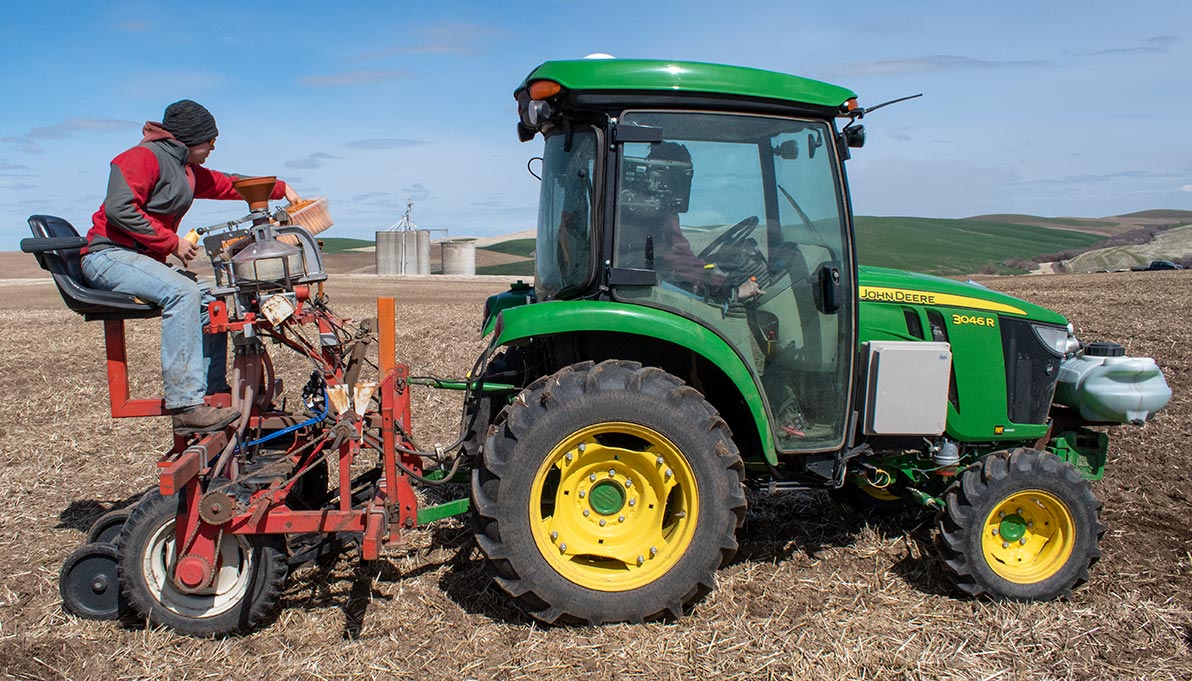
Seeding Rates
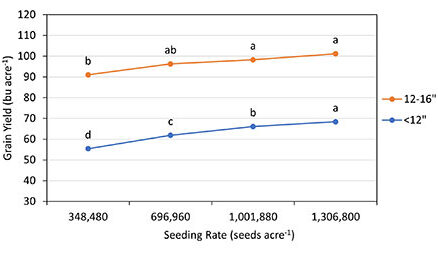
In 2018 and 2019, four seeding rates of soft white winter wheat were planted across eight environments. A very clear trend across all locations emerged indicating that higher seeding rates increased grain yield from 350,000 through 1.3 million seeds per acre, though there was a rate of diminishing returns observed as seeding rate went up (Figure 1). In general, seeding rate had limited impact on test weight. Only two site years showed differences where the lowest rate had the lowest test weight with no differences present among the other rates. Impacts on grain protein, heading date, and plant height were minimal or nonexistent at all sites. It is important to point out that 2018 was an above-average year for moisture and yield, while 2019 was closer to average. Abundant moisture may have allowed a higher plant population to take advantage of the additional moisture.
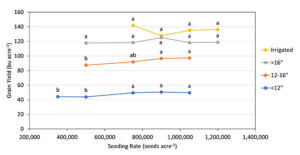
In 2022, the hard red winter wheat variety Keldin was planted at various seeding rates at all Washington State University (WSU)Extension variety trial sites. Only six out of the 14 sites showed a statistical difference among seeding rates. In zones receiving less than 16 inches of annual precipitation, there was a consistent bump in yield (four to six bushels) from 500,000 to 750,000 seeds per acre with no significant yield advantage observed beyond that rate (Figure 2). In the dryland sites receiving more than 16 inches of precipitation, along with the irrigated sites, there was no observed difference among rates. Yields in 2022 in the below-12-inch precipitation zone were closer to average for the area, and thus lower available moisture may have favored lower plant populations than in 2018. The 2022 trials in the low rainfall zone were all planted late due to the dry fall in 2021, which limited fall tillering, but the long, cool spring in 2022 favored development of more productive spring tillers. Little difference was detected for test weight, grain protein, heading date, and plant height among the different seeding rates.
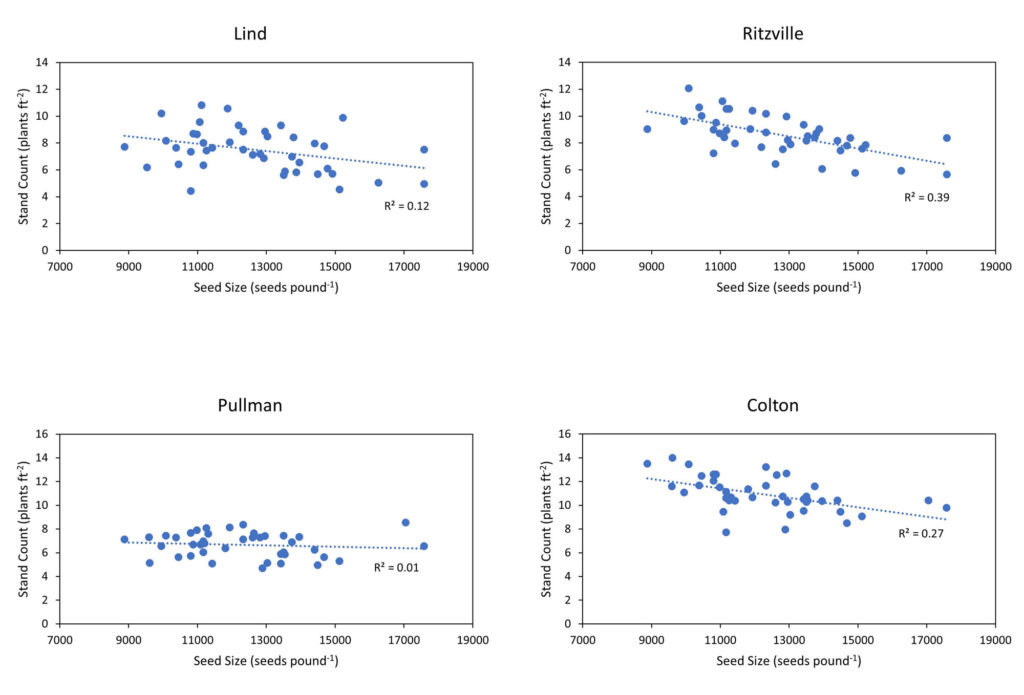
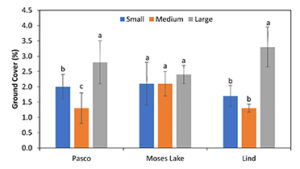
For winter wheat seeding rates, the most consistent finding was zero cases where higher seeding rates had a negative impact on yield. One possible advantage from going with higher seeding rates is to compensate for smaller seed size, which may have more difficulty emerging through heavy residue or dry soil conditions. Weed scientists will also tell you that a vigorous crop is one of the best tools in weed control or suppression. More seeds generally mean more plants and faster canopy cover to snuff out weeds and reduce dependence on chemical and mechanical control. Furthermore, with certified seed selling at roughly 25 cents per pound, an additional 250,000 seeds per acre (equal to 19 pounds of seed if you assume approximate seed size of 13,000 seeds per pound) only costs an additional $4.81 per acre. One extra bushel of wheat will more than pay for this additional cost.
In the higher rainfall and irrigated zones, growers should be more hesitant to go with higher rates. There was no evidence that higher rates would increase yield potential, which suggests growers could save costs by cutting back seeding rates. Lodging was also a factor in some trials in 2022 where higher rates trended towards higher lodging potential.
Seed Size
In fall 2022, seed from soft white wheat variety LCS Shine was sifted into a “large” (10,810 seeds per pound) and “medium” (13,432 seeds per pound) seed size treatment from the same seed source. These treatments were planted at Lind, Harrington, Ritzville (all deep furrow sites), and Horse Heaven (direct seeded with hoe drill). When averaged across all four sites, the larger seed size increased stand counts by 1.4 (22%) plants per square foot. At Lind, the larger seed size produced eight more bushels per acre.
As a follow up to this study, fall stand counts were taken for all varieties in the soft white wheat variety trials at Lind, Ritzville, Colton, and Pullman and were compared to seed sizes of each entry planted in those trials in fall 2022 (Figure 3). At Ritzville, stand count was reduced by 4% every time seed number per pound increased by 1,000 seeds. Lind showed a similar trend but had a weaker relationship. This is not overly surprising given these two locations are deep-furrow sites, and seeds rely on stored energy to push through six or more inches of soil before emerging. No trend was observed at the Pullman site, however, there was again a negative trend at Colton. Colton was a direct-seeded site planted with a hoe-opener-type drill, whereas Pullman was planted with a conventional double disk drill, which may have played a role in the differences between the two high rainfall sites.
While not a winter wheat, three seed sizes were planted in 2023 of soft white spring wheat variety Ryan at three locations. Results show that while stand counts did not differ by seed size, there was a significant bump in ground cover at Pasco and Lind with the largest seed size (Figure 4).
More information is needed to better understand these relationships in order to formulate more accurate recommendations for ideal seeding rates. An online calculator is also available on the WSU Small Grains Extension website to help growers convert among pounds per acre, seeds per acre, seeds per square foot, and seeds per foot of row using seed size. Growers are encouraged to experiment with their own seeding rates to determine the best rate for their operation. While growers may have limited control over seed size, knowing the impact seed size can have on stand and ground cover may inform them on whether seeding rates need to be adjusted to compensate for small or large seed. This is particularly true under less-than-ideal planting conditions when smaller seed is more likely to result in reduced stands.
This article originally appeared in the August 2023 Issue of Wheat Life Magazine.


